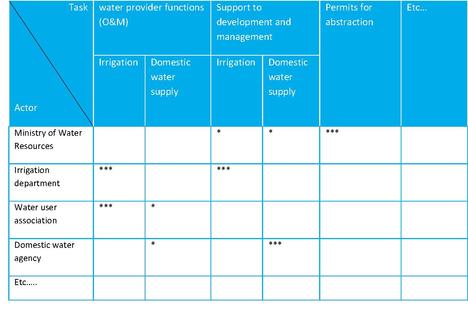Tool 23
TOOL 23. ACTOR AND TASK ANALYSIS
To have a clear understanding of the different stakeholders involved in MUS, or involved in different aspects of water service provision and management, and their roles and responsibilities. To identify potential gaps or overlaps in the roles of different stakeholders. To understand the links between different stakeholders, especially those related to the sharing and use of information.
A wide range of stakeholders is involved in the provision of multiple-use water services. Understanding who these stakeholders are and their different roles and responsibilities is a crucial starting point in understanding where improvements can be made in MUS. This tool helps stakeholders to identify the most important roles and linkages. It aids them in identifying and visualising tasks related to the provision of water services, allowing the key coordinating linkages to be seen in relations between the different stakeholders and their tasks.
Actor and task analysis can be carried out both in workshops and by using other approaches such as semi-structured interviews. However, at some point it is important that relevant stakeholders are able to see the totality of the analysis being developed – and to understand and discuss their roles within it.
OBJECTIVE
- To have a clear understanding of the different stakeholders involved in MUS, or involved in different aspects of water service provision and management, and their roles and responsibilities.
- To identify potential gaps or overlaps in the roles of different stakeholders.
- To understand the links between different stakeholders, especially those related to the sharing and use of information.
METHOD
The main framework used for the analysis is the actors and tasks matrix (see Table 16 for an example). Each row represents a different actor involved in the water system, while each column identifies a key task and role.
The matrix is filled in based on discussions with stakeholders in workshops or interviews. The matrix then reveals information about gaps and overlaps in relation to essential tasks and the actors who perform them.
A number of guiding questions can be used in either workshops or interviews to prompt stakeholders, these include:
- Which tasks/functions are performed by which actors?
- What activities do the actors carry out in performing these tasks? How effective are they?
- What gaps are there between tasks?
- What overlap is there between different actors/tasks?
- Is there a coordinated effort by relevant actors to integrate their tasks?
- What factors within the system have a positive or negative influence on task performance?
- What information is held by which stakeholders that helps them to perform their tasks? Is it shared? If so, how?
Table 16 - Actors and tasks matrix

Source: Based on Moriarty, et al., 2007
Note: Stars represent the relative importance of the role.
TIPS AND TRICKS
- The quality of the output in this exercise is highly dependent on good quality facilitation and access to up-to-date knowledge, for example, on the roles and responsibilities of government departments. The roles and responsibilities of departments often reflect the policies of political parties and are therefore subject to change.
BASED ON
Moriarty, P., et al., 2007. The EMPOWERS Approach to Water Governance: Guidelines, Methods and Tools. Amman: INWRDAM.
Adapted from the RAAKS (rapid appraisal of agricultural knowledge systems) toolbox (tool B5). Available at: http://www.kit.nl/smartsite.shtml?ch=FAB&id=4616&Part=Resources.
